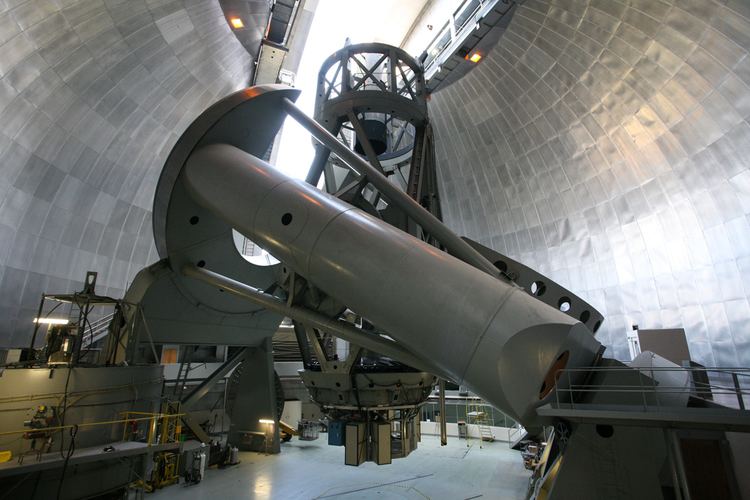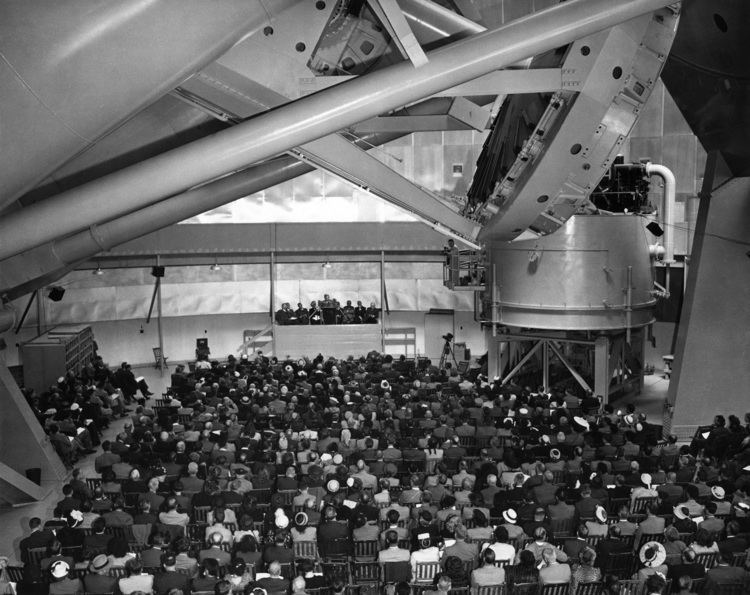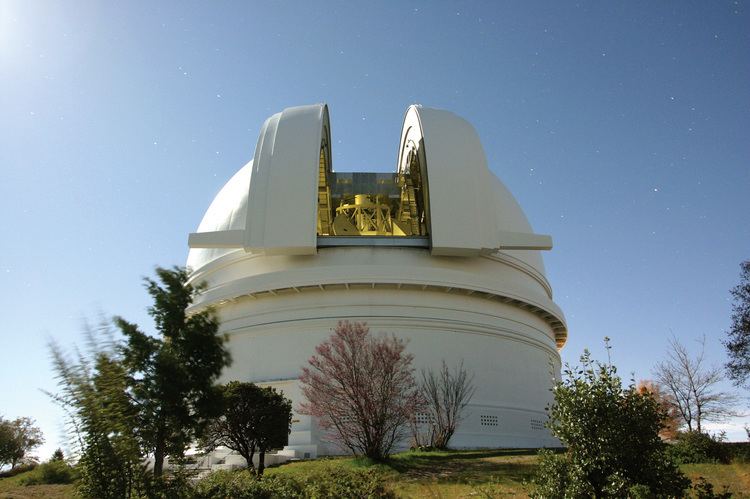Built 1936–1948 (1936–1948) Elevation 1,713 m | Altitude 1,713 m (5,620 ft) | |
 | ||
First light January 26, 1949, 10:06 pm PST | ||
Aluminization of the 200 inch hale telescope mirror at palomar observatory
The Hale Telescope is a 200-inch (5.1 m), f/3.3 reflecting telescope at the Palomar Observatory in California, US, named after astronomer George Ellery Hale. With funding from the Rockefeller Foundation, he orchestrated the planning, design, and construction of the observatory, but did not live to see its commissioning. The Hale was groundbreaking for its time, with double the diameter of the next largest telescope and pioneering the use of many technologies such as vapor deposited aluminum and low thermal expansion glass. It is still in active use.
Contents
- Aluminization of the 200 inch hale telescope mirror at palomar observatory
- Palomar observatory 200 inch hale telescope evening tour
- History
- Mounting structures
- 200 inch mirror
- Direct imaging of exoplanets
- Comparison
- References

It was the largest optical telescope in the world from its completion in 1948 until the BTA-6 was built in 1976, and the second largest until the construction of the Keck 1 in 1993.

Palomar observatory 200 inch hale telescope evening tour
History

Hale supervised the building of the telescopes at the Mount Wilson Observatory with grants from the Carnegie Institution of Washington: the 60-inch (1.5 m) telescope in 1908 and the 100-inch (2.5 m) telescope in 1917. These telescopes were very successful, leading to the rapid advance in understanding of the scale of the Universe through the 1920s, and demonstrating to visionaries like Hale the need for even larger collectors.

The chief optical designer for Hale's previous 100-inch telescope was George Willis Ritchey, who intended the new telescope to be of Ritchey–Chrétien design. Compared to the usual parabolic primary, this design would have provided sharper images over a larger usable field of view. However, Ritchey and Hale had a falling out. With the project already late and over budget, Hale refused to adopt the new design, with its complex curvatures, and Ritchey left the project. The Mount Palomar Hale telescope turned out to be the last world-leading telescope to have a parabolic primary mirror.
In 1928 Hale secured a grant of $6 million from the Rockefeller Foundation for "the construction of an observatory, including a 200-inch reflecting telescope" to be administered by the California Institute of Technology (Caltech), of which Hale was a founding member. In the early 1930s, Hale selected a site at 1,700 m (5,600 ft) on Palomar Mountain in San Diego County, California, US, as the best site, and less likely to be affected by the growing light pollution problem in urban centers like Los Angeles. The Corning Glass Works was assigned the task of making a 200-inch (5.1 m) primary mirror. Construction of the observatory facilities and dome started in 1936, but because of interruptions caused by World War II, the telescope was not completed until 1948 when it was dedicated. Due to slight distortions of images, corrections were made to the telescope throughout 1949. It became available for research in 1950.
The 200-inch (510 cm) Hale saw first light on January 26, 1949 under the direction of American astronomer Edwin Powell Hubble, targeting NGC 2261, an object also known as Hubble's Variable Nebula. The photographs made then were published in the astronomical literature and in the May 7, 1949 issue of Collier's Magazine.
The telescope continues to be used every clear night for scientific research by astronomers from Caltech and their operating partners, Cornell University, the University of California, and the Jet Propulsion Laboratory. It is equipped with modern optical and infrared array imagers, spectrographs, and an adaptive optics system. It has also used lucky cam imaging, which in combination with adaptive optics pushed the mirror close to its theoretical resolution for certain types of viewing.
One of the Corning Labs' glass test blanks for the Hale was used for the C. Donald Shane telescope's 120-inch (300 cm) primary mirror.
The collecting area of the Hale is about 31,000 square inches (20 square meters).
Mounting structures
The Hale telescope uses a special type of equatorial mount called a "horseshoe mount", a modified yoke mount that replaces the polar bearing with an open "horseshoe" structure that gives the telescope full access to the entire sky, including Polaris and stars near it. The optical tube assembly (OTA) uses a Serrurier truss, then newly invented by Mark U. Serrurier of Caltech in Pasadena in 1935, designed to flex in such a way as to keep all of the optics in alignment. Theodore von Karman designed the lubrication system to avoid potential issues with turbulence during tracking.
200-inch mirror
Originally, the Hale telescope was going to use a large fused quartz block manufactured by General Electric, but instead the primary mirror for the Hale telescope was cast in 1934 at Corning Glass Works in New York State using Corning's then new material called Pyrex (borosilicate glass). Pyrex was chosen for its low expansion qualities so the large mirror would not distort the images produced when it changed shape due to temperature variations (a problem that plagued earlier large telescopes).
The mirror was cast in a mold with 36 raised mold blocks (similar in shape to a waffle iron). This created a honeycomb mirror that cut the amount of Pyrex needed down from over 40 tons to just 20 tons, making a mirror that would cool faster in use and have multiple "mounting points" on the back to evenly distribute its weight (note – see external links 1934 article for drawings) . The shape of a central hole was also part of the mold so light could pass through the finished mirror when it was used in a Cassegrain configuration (a Pyrex plug for this hole was also made to be used during the grinding and polishing process). While the glass was being poured into the mold during the first attempt to cast the 200-inch mirror, the intense heat caused several of the molding blocks to break loose and float to the top, ruining the mirror. The defective mirror was used to test the annealing process. After the mold was re-engineered, a second mirror was successfully cast.
After cooling several months, the finished mirror blank was transported by rail to Pasadena, California. Once in Pasadena the mirror was transferred from the rail flat car to a specially designed semi-trailer for road transport to where it would be polished. In the optical shop in Pasadena (now the Synchrotron building at Caltech) standard telescope mirror making techniques were used to turn the flat blank into a precise concave parabolic shape, although they had to be executed on a grand scale. A special 240-inch 25,000 lb mirror cell jig was constructed which could employ five different motions when the mirror was ground and polished. Over 13 years almost 10,000 pounds of glass was ground and polished away reducing the weight of the mirror to 14.5 tons. The mirror was coated (and still is re-coated every 18–24 months) with a reflective aluminum surface using the same aluminum vacuum-deposition process invented in 1930 by Caltech physicist and astronomer John Strong.
The Hale's 200-inch mirror was near the technological limit of a primary mirror made of a single rigid piece of glass. Using a monolithic mirror much larger than the 5-meter Hale or 6-meter BTA-6 is prohibitively expensive due to the cost of both the mirror, and the massive structure needed to support it. A mirror beyond that size would also sag slightly under its own weight as the telescope is rotated to different positions, changing the precision shape of the surface, which must be accurate to within 2 millionths of an inch (50 nm). Modern telescopes over 9 meters use a different mirror design to solve this problem, with either a single thin flexible mirror or a cluster of smaller segmented mirrors, whose shape is continuously adjusted by a computer-controlled active optics system using actuators built into the mirror support cell.
Direct imaging of exoplanets
Up until the year 2010, telescopes could only directly image exoplanets under exceptional circumstances. Specifically, it is easier to obtain images when the planet is especially large (considerably larger than Jupiter), widely separated from its parent star, and hot so that it emits intense infrared radiation. However, in 2010 a team from NASA's Jet Propulsion Laboratory demonstrated that a vortex coronagraph could enable small scopes to directly image planets. They did this by imaging the previously imaged HR 8799 planets using just a 1.5 m portion of the Hale telescope.
Comparison
The Palomar Hale had four times the light collecting area of the next largest scope when it was commissioned in 1949. Other contemporary telescopes were the Hooker Telescope at the Mount Wilson Observatory and the Otto Struve Telescope at the McDonald Observatory.
